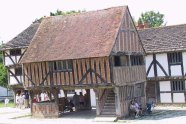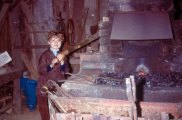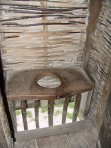Wednesday, 22 June 2005
King Solomon's Mines
Topic: Films and TV
Today is the anniversary of the birth of the British author,
Sir Henry Rider Haggard, who was born in
Bradenham, Norfolk, on 22nd June 1856. He wrote a number of first-class adventure novels but his most famous book is probably "
King Solomon's Mines", first published in 1885. It was an instant best-seller. H. Rider Haggard lived for some years in Natal, Africa, and is said to have had an affair with an African woman. Certainly, his sympathy for the native population comes through very strongly in his books.
Of course, it wasn't long before the film industry showed an interest in his stories and "King Solomon's Mines" was turned into a film. Actually, at least three films and a TV mini series have been made based on Rider Haggard's famous book. The first film, made in 1937 and largely forgotten, starred
Paul Robeson and
Sir Cedric Hardwick. The most recent version, made in 1985, starred
Richard Chamberlain and
Sharon Stone. However, the one I saw (and probably the best out of the three) was the
1950 version starring
Stewart Grainger and
Deborah Kerr.
I must have been 8-years-old when I was taken to see the film in London. The film tells the story of an adventurer who helps a woman look for her lost husband in Africa. I know I was totally enthralled with the African wildlife and the marvellous scenery. I believe two elephants were actually filmed being shot but I don't remember the carnage! I do remember that I particularly liked Umbopa, the tall black Prince with a snake carved into his stomach. I was very impressed also with the
Watutsi, that African tribe of very tall people, and their marvellous dancing and singing. (The Watutsi are also known as the
Tutsi, many of whom were slaughtered in their thousands by the Hutu in 1993.)
The film won well deserved Academy Awards for Best Cinematography, Color and Best Film Editing and was also nominated for Best Picture.
Monday, 20 June 2005
Father's Day
Topic: Family Days Out
My, it was hot yesterday and it's not much better today - can't cool down! We had a lovely day yesterday as all the family met at the
Open Air Museum at Singleton, not far from Chichester. Three proud Dads all celebrating Father's Day with the children and grandchildren. Thank goodness for a couple of big shady trees to sit under and enjoy the lovely picnic lunch my daughter brought.

The Museum is a collection of very old historic buildings which were rescued from demolition, carefully moved from their original sites and reconstructed in the West Sussex countryside for posterity to enjoy. One thing I noticed is how cool all these medieval buildings are inside - wish our house was as cool on a hot summer's day! Yesterday was a 'Father's Day' theme and there were all sorts of craft demonstrations to try your hand at. It was too hot to have a go at the
Pit Sawing but my son-in-law, Adrian, tried his hand at
Pole Lathe Turning. He got the foot treadle movement just right and was told that he was a natural "
Bodger"!
I felt sorry for the Blacksmith

demonstrating his trade in the Smithy. Warm work at the best of times let alone on such a hot day. To make matters worse, the Blacksmith was wearing a thick leather apron and what looked like flying boots to protect him from the sparks! I reminded my son about a previous visit many years ago when he was about 7-years-old. David had been completely fascinated by the Blacksmith then and I couldn't get him away from the Forge - he spent over an hour working the bellows. The Blacksmith was making a replica axe head, heating it in the fire and beating it with a hammer. When he finished it, he presented it to David as a reward for all his hard work. That wouldn't happen today as there is a cordon preventing the public from getting too close.
My daughter had a whale

of a time trying her hand at driving a tractor whilst all the grandchildren had rides on a buggy pulled by a couple of giant cart-horses and on a tractor trailer with hay bale seats which took them round the field. We sat under the trees sipping water and watching. We weren't able to visit all the buildings as the site is very large and it was too hot to gallop round. But, I just had to have another look inside my favourite building, the Bayleaf Farmhouse. This is quite a large timber framed hall house, originally from Kent, dating from the late 15th or early 16th century. The feature I like best is the 'toilet' in the upstairs bedroom which consists of a projection overhanging the back garden with a seat with a round hole over a disposal pit. Bit drafty but it was the height of luxury in the early 16th century!
We ended our day at the Royal Oak public house near Midhurst. We had marvellous food but the helpings were
really huge, no room for a pudding or even an ice cream!
Saturday, 18 June 2005
Tiger, Tiger....
Mood:
 caffeinated
Topic: Poetry and Poets
caffeinated
Topic: Poetry and Poets
I met a llama called Miguel on
BlogPartyWeekend.com, one of
Michael's sites. Just had to get my own pet - isn't she cute! Her name means 'Night'. Listen carefully - she growls sometimes! We both like the poem written by William Blake about the fearsome tiger.
|
|
The Tiger |
TIGER, tiger, burning bright
In the forests of the night,
What immortal hand or eye
Could frame thy fearful symmetry?
In what distant deeps or skies
Burnt the fire of thine eyes?
On what wings dare he aspire?
What the hand dare seize the fire?
And what shoulder and what art
Could twist the sinews of thy heart?
And when thy heart began to beat,
What dread hand and what dread feet?
What the hammer? what the chain?
In what furnace was thy brain?
What the anvil? What dread grasp
Dare its deadly terrors clasp?
When the stars threw down their spears,
And water'd heaven with their tears,
Did He smile His work to see?
Did He who made the lamb make thee?
Tiger, tiger, burning bright
In the forests of the night,
What immortal hand or eye
Dare frame thy fearful symmetry?
|
William Blake (1757-1827) |
|
Updated: 18 June 2005 14:33 BST
Friday, 17 June 2005
Microcalcification
Topic: Health Issues
Just over four weeks ago, I had to attend the mobile unit in the Festival Theatre Car Park in Chichester for a routine breast screening X-ray or
mammogram. They look after you very well in West Sussex and call all women between the ages of 50 and 64 for screening every three years, a scheme which they are gradually changing to include women up to 70 years of age.
Then, last week the letter arrives, "Please would you attend Worthing Hospital Assessment Centre for further tests". So, off I went last Wednesday. It was the left side they were interested in - more squashing between glass plates from various angles! Then the radiographer had to change all the plates to take yet another X-ray with a magnified film of the area. "That's it, you can get dressed and we will call you in a few minutes to see the Doctor".
Five minutes later, I am shown into the Consultant's room. All my X-rays are on a light board. He points at a tiny cluster of white dots; "These are tiny particles of calcium which we call Microcalcification", he said. He explained that these minute calcium deposits were, in all probability, harmless but, that they
could represent a pre-cancerous condition known as Ductal Carcinoma in Situ (DCIS). Despite the carcinoma tag, DCIS is non cancerous and cannot spread. However, if it is left, there is a chance that it could develop into a proper cancer eventually.
To determine whether DCIS is present, a sample is needed. That means, a stereo tactic core biopsy through a hollow needle. Sounds horrible but they give you a local anaesthetic and I was assured it would not be painful. "Are you needle phobic?" Well, I don't think so, after all I have donated blood over sixty times!
My appointment is on the 5th July and then I will have to return again to hear the result and find out if the microcalcification is benign, a very common condition requiring no treatment, or if they want to remove a chunk out of me! Will let you know how I get on.
Wednesday, 15 June 2005
Cockroaches and Human Fertility
Topic: In the News
So, it appears that the lowly cockroach, that detested insect pest, shares more with us ladies than just our kitchens. Biologists at Manchester University, who are undertaking research into increased fertility problems in women who put off having children until they are older, now believe that cockroaches hold the key to
the mysteries of women's fertility.
They are particularly interested in the mating behaviour of the dusky roach (Nauphoet cinera). The female cockroach is unusual as she bears live young and also experiences reproductive cycles and becomes less fertile with age. If breeding is delayed, the cockroaches lose reproductive potential apparently due to a
biochemical reaction which may be similar to that of human beings. Now, I ask myself, why do scientists spend so much time and so many resources on human fertility when half of the world population is starving?
If we believe what we are told, it is possible that in another fifty to sixty years scientists will have conquered
ageing, that inevitable process which causes the human cell to divide and reproduce a finite number of times with increasing errors. If that happens, my great, great grandchildren may be able to look forward to living to be 150 years old but - in what sort of world?
We have problems today with a growing percentage of pensioners compared to the working population. So, shouldn't a curb be put on human reproduction instead of trying to prolong human fertility? Do we really want to see women of sixty or seventy still bearing children? Do we really want to have to carry on working until we are ninety? Is the ultimate fate of mankind to live packed like sardines in mile-high tenements? In such a world, I envisage most people having to work from home because public transport and road systems can no longer cope. A nightmarish future where there are so many people that 'shifts' have to be imposed for recreational purposes or for shopping.
Learning all we can about the human genome is a good thing. But I wonder if scientists are considering all the consequences for humanity when they dream about prolonging human fertility.
Monday, 13 June 2005
World's Best Character Actor
Topic: In the News

Do you think that this man could be mistaken for 15 year old boy? Well, he was and more than once it seems! He is Frederic Bourdin, a Frenchman nicknamed the '
Chameleon'. He is a balding 31-year-old but he still managed to fool French social workers and fellow pupils at a school in Pau into believing that he was a teenage orphan. Can you believe that he actually spent a month in a children's home and at the school without raising suspicion! He was only found out because a teacher happened to watch a television documentary about his previous exploits and recognised him.
Apparently, "
he dyed his greying hair blond, meticulously shaved his beard, applied facial hair remover and covered his bald patch with a baseball cap to achieve the desired effect". [see
Telegraph]. He changed his voice and also fooled all his classmates with his perfect mastery of teenage gestures and slang! How on earth can somebody live a deception like that for several weeks without making a mistake!
He is obviously a born actor and, under different circumstances, would probably have been nominated for an Oscar for his performances. Instead, the disturbed imposter turned his talent to criminal impersonations of at least 36 imaginary teenagers plus taking on the identities of three missing boys!
Computer Decisions
Topic: Computer
I was telling myself about 18 months ago that I needed to replace my Toshiba Laptop. Then, in April 2004, I crashed my computer and got it back with a new 20 GB hard disk. The old one was just 6.4 GB - yes, that's right, 6.4 billion bytes! No wonder I had been running out of memory. I decided to wait a bit longer. After all, they bring out new, more advanced models all the time.
Well, I can't wait very much longer. This old machine is moribund and one day, sooner rather than later, it will go to that great network up in the sky. It often hangs on start up and then I get a message to tell me that the Angel Microsoft has 'restored a good registry'. It is incredibly slow, even after defragging. I can't play games like the Scrabble game my husband bought because the Video RAM is, wait for it, 2.5 MB! And now, to add to my woes, I have managed to break my DVD drive!
My problem is which make and model of Notebook to go for - I suppose I am a typical female who can't make up her mind! But it is a confusing world. What is the difference between Intel Pentium M Centrino and Intel Pentium 4 for a start? Well, what do I know that I want? I haven't got much space so a Laptop is ideal - a desktop replacement with a lot of internal memory and the biggest hard disk I can get. I want a DVD/CD burner and a good video memory. I would like to add a Blue Tooth whatever to my HP printer so that I don't have to be within two feet of it! And I would like wireless capability so that I can sit in the garden with my laptop or anywhere in the house. I would like to go Broadband. However, I still want to be able to connect to my 'phone line for the time being as I probably won't be able to set everything up at once. Oh, yes, I must have a mouse - can't get on with things like the Accupoint control this machine has.
I've looked at Toshiba and Sony and Hewlett Packard and Dell and IBM. I was briefly tempted by the Qosmio but I don't really need a computer that is also a television. Now I am looking at the Acer Notebooks - at least that is a British firm. I was warned not to buy from the usual high street outlets (i.e., PC World, etc.) as, although models might be 'good value', they are likely to have sub-standard chassis, or whatever you call them. Also, because they are put together in some remote Asiatic land, you can't get spare parts easily.
I might go for the Acer TravelMate 8104WLMi - it has an impressive 100 GB hard disk and 1024 MB of RAM installed. It doesn't appear to have a parallel port but it does have Bluetooth and Ethernet, and four USB Ports. Is there a modem jack? What is SPDIF In and Out? Perhaps I had better look around a bit more. I bought a couple of magazines on Sunday morning, 'Computer Buyer' and 'What Laptop'. Better get reading.
Saturday, 11 June 2005
Food for Thought
Topic: Recipes and Food
Have you ever tried
tapioca pudding? My mother used to prepare lots of rice puddings and tapioca puddings when I was small but I haven't eaten one for years. Recently, I read how tapioca is made. It actually comes from the tuberous root of Cassava or Manioc, a shrubby plant originating in South America and now one of the world's most important food crops. Manioc was probably first cultivated by the Maya Indians but it has a serious disadvantage - the starchy root actually contains a poisonous compound called linamarin which can produce cyanide if eaten raw. So the root has to be washed and peeled, shredded or grated and then soaked for several days to allow the plant's natural enzymes to convert the toxic linamarin to sugar and cyanide gas - the gas then dispersing harmlessly. When the shredded root is soaked in clean water and left, starch settles. The water is then poured off and the process is repeated four or five times. Finally, the starch is collected and cooked and stirred until little balls or pearls of tapioca are formed.
The South American
Indians used to squeeze the manioc pulp in a special basket called a 'tipiti' to remove any toxic juice before washing and then they roasted the remains. The result was a coarse meal or flour known as 'farinha de mandioca'. Starch settling out from the extracted juice was then heated on a flat surface, causing individual starch grains to pop open and clump together into small, round granules (tapioca). The remaining juice was boiled down to destroy any poison and used as a sauce called 'tucupi'. Now all that is really quite amazing. How did anyone ever discover that a poisonous tuberous root could be shredded and pummelled and washed and cooked to make it edible?
The evolution of cooking (if that is the right term!) is extremely intriguing. Today, human beings cultivate and eat a huge variety of fruits, vegetables,
grains, beans and seeds but, in the distant past, those food sources were far from abundant and difficult to find. Also, many plants, such as grains, were spindly prototypes of today's plump cultivated varieties. So, how did our hunter gatherer ancestors learn what they could eat and how to prepare it? Some mammals can eat plants which are poisonous to human beings so how many early humans died through experimenting with alternative food sources they had observed other creatures eating? For that matter, how many died from eating unprocessed manioc? Hunger must have been a very powerful driving force to make people experiment with ways of preparing something they knew could make them very ill or even kill them.
Homo Erectus and other early hominids would have hunted for meat but they would also have eaten every seed they could find. Anything bean-like or pea-like would have been stripped off the bushes, together with wild berries or nuts and the stems or roots of starchy plants. But how did early man ever think of grinding millet or other grains into flour and then mixing it with water to make a dough? Perhaps they started by grinding nuts and seeds when their teeth began to wear down! Certainly, many nuts and seeds are more nutritious when broken down by grinding as that releases more of the protein. (One good reason to chew food well). So, was it an accidental soaking of ground up seeds that forced them to try to 'dry' it over a fire?
Actually, it is easy to understand how early man thought of roasting nuts or burning off seed husks or roasting meat - it would have just needed a forest fire to flash through their hunting grounds for the concept of cooking to take hold. Although many foods, including fish and meat, can be eaten raw, they are undoubtedly less of a strain on the digestive system, and probably more tasty as well, if they are eaten cooked. One reason is that many seeds contain substances like tannins which are destroyed or greatly reduced by cooking, thereby making them more nutritious and much easier to digest and people would have been quick to notice the advantages and to learn how to harness the power of fire.
It seems that everywhere that early humans went, they found some new foodstuff to eat. I think that we owe a great deal to the resourcefulness of so called 'primitive man' who was actually very clever and extremely knowledgeable about his environment. They knew what to eat and how to prepare it and they also knew what plants and herbs could cure various ailments - something which today's scientists are still learning about from old '
folk medicine'.
Today, human beings worldwide eat and enjoy a huge variety of foodstuffs. We, in the Western World, are particularly fortunate when it comes to food. We just take a trip to the supermarket and load up our trolleys with whatever we fancy or can afford. Yorkshire puddings, meat pies, rhubarb crumble, Indian curry, Chinese sweet and sour pork - you name it, it's in a cabinet somewhere. Everything is prepared for us from lamb chops to fish fingers. We can enjoy any vegetable out of season from the frozen food cabinet or buy exotic fruit flown in from all over the world. We can buy packets of 'freshly prepared' vegetables all sliced up and ready to cook, even peeled potatoes ready for boiling! So much so that some young people, (like the girl who served me once in Marks and Spencers), have no idea what peas, broad beans or runner beans look like before podding or slicing. Our great grand-parents, who had to bottle and preserve, would be utterly amazed.
Wednesday, 8 June 2005
Ooops!
Topic: Humorous
Here are a couple of 'funnies' that my husband heard on BBC Radio Two's, "Wake up with Wogan", this morning between 8 and 9 am. Purportedly, both true stories.
A man goes into a newsagents and asked the girl, "Do you sell first class stamps?" "Yes, sir", she replied. "Oh, good. I'll have a dozen, please." "Oh, I'm sorry, sir. We only sell them in books of twelve".
A gentleman boards an aeroplane at Dublin carrying a packet of fresh edible crabs. He asked the Air Hostess if she would be kind enough to store them in the refrigerator in the galley. "Certainly, sir. No problem". Relieved, he made his way to his seat. On landing, the tannoy comes on. The Air Hostess had an announcement. "Would the gentleman who gave me the crabs at Dublin please come and identify himself".
World Ocean Day
Topic: Special Days
World Ocean Day was created at the 1992 Earth Summit in Rio de Janeiro and is celebrated annually on the 8th June. At the moment, the organisers are campaigning to have this day recognised and officially designated by the United Nations. They need 10,000 signatures. If you care about our oceans, why not sign this petition. You can do it online
HERE.
One of the most damaging of ocean activities is the practice of
deep-sea trawling. Everything, edible or not, is scooped up in the heavy nets. Coral is destroyed and fragile ecosytems are gone forever. The ocean floor is left a barren desert, with no shelter or food for the myriad of tiny fish fry. This practise should be banned as a matter of urgency. The Deep Sea Conservation Coalition has just released a white paper highlighting this problem,
Six Good Reasons for a time-out on high seas bottom trawling. If something is not done soon, many fish will become extinct. Cod is already endangered and it is a fact that the mature breeding population is virtually non-existent. This means that immature fish are now breeding much earlier than normal. What effect this will have on the fish stock is unknown.
I can remember my Dad telling me that the sea was a wonderful source of food for mankind which would never run out. But it is running out. Also, the seas act as the lungs for our world and provide vast amounts of oxygen. However, if we turn the oceans into dank, polluted water deserts, what will happen then?
Do you want to have to explain to your grandchildren or great grandchildren what Fish 'n Chips tasted like? I certainly don't. Now is the time for our generation to do something before it is too late. One way is to support the campaign for the preservation of our beautiful oceans and their diverse marine life. We must do this for our descendants' sakes before it is too late and that point of no return is looming closer day by day. Go on, sign that petition now - I have.
Newer | Latest | Older





 The Museum is a collection of very old historic buildings which were rescued from demolition, carefully moved from their original sites and reconstructed in the West Sussex countryside for posterity to enjoy. One thing I noticed is how cool all these medieval buildings are inside - wish our house was as cool on a hot summer's day! Yesterday was a 'Father's Day' theme and there were all sorts of craft demonstrations to try your hand at. It was too hot to have a go at the Pit Sawing but my son-in-law, Adrian, tried his hand at Pole Lathe Turning. He got the foot treadle movement just right and was told that he was a natural "
The Museum is a collection of very old historic buildings which were rescued from demolition, carefully moved from their original sites and reconstructed in the West Sussex countryside for posterity to enjoy. One thing I noticed is how cool all these medieval buildings are inside - wish our house was as cool on a hot summer's day! Yesterday was a 'Father's Day' theme and there were all sorts of craft demonstrations to try your hand at. It was too hot to have a go at the Pit Sawing but my son-in-law, Adrian, tried his hand at Pole Lathe Turning. He got the foot treadle movement just right and was told that he was a natural " demonstrating his trade in the Smithy. Warm work at the best of times let alone on such a hot day. To make matters worse, the Blacksmith was wearing a thick leather apron and what looked like flying boots to protect him from the sparks! I reminded my son about a previous visit many years ago when he was about 7-years-old. David had been completely fascinated by the Blacksmith then and I couldn't get him away from the Forge - he spent over an hour working the bellows. The Blacksmith was making a replica axe head, heating it in the fire and beating it with a hammer. When he finished it, he presented it to David as a reward for all his hard work. That wouldn't happen today as there is a cordon preventing the public from getting too close.
demonstrating his trade in the Smithy. Warm work at the best of times let alone on such a hot day. To make matters worse, the Blacksmith was wearing a thick leather apron and what looked like flying boots to protect him from the sparks! I reminded my son about a previous visit many years ago when he was about 7-years-old. David had been completely fascinated by the Blacksmith then and I couldn't get him away from the Forge - he spent over an hour working the bellows. The Blacksmith was making a replica axe head, heating it in the fire and beating it with a hammer. When he finished it, he presented it to David as a reward for all his hard work. That wouldn't happen today as there is a cordon preventing the public from getting too close. of a time trying her hand at driving a tractor whilst all the grandchildren had rides on a buggy pulled by a couple of giant cart-horses and on a tractor trailer with hay bale seats which took them round the field. We sat under the trees sipping water and watching. We weren't able to visit all the buildings as the site is very large and it was too hot to gallop round. But, I just had to have another look inside my favourite building, the Bayleaf Farmhouse. This is quite a large timber framed hall house, originally from Kent, dating from the late 15th or early 16th century. The feature I like best is the 'toilet' in the upstairs bedroom which consists of a projection overhanging the back garden with a seat with a round hole over a disposal pit. Bit drafty but it was the height of luxury in the early 16th century!
of a time trying her hand at driving a tractor whilst all the grandchildren had rides on a buggy pulled by a couple of giant cart-horses and on a tractor trailer with hay bale seats which took them round the field. We sat under the trees sipping water and watching. We weren't able to visit all the buildings as the site is very large and it was too hot to gallop round. But, I just had to have another look inside my favourite building, the Bayleaf Farmhouse. This is quite a large timber framed hall house, originally from Kent, dating from the late 15th or early 16th century. The feature I like best is the 'toilet' in the upstairs bedroom which consists of a projection overhanging the back garden with a seat with a round hole over a disposal pit. Bit drafty but it was the height of luxury in the early 16th century!  Do you think that this man could be mistaken for 15 year old boy? Well, he was and more than once it seems! He is Frederic Bourdin, a Frenchman nicknamed the '
Do you think that this man could be mistaken for 15 year old boy? Well, he was and more than once it seems! He is Frederic Bourdin, a Frenchman nicknamed the '